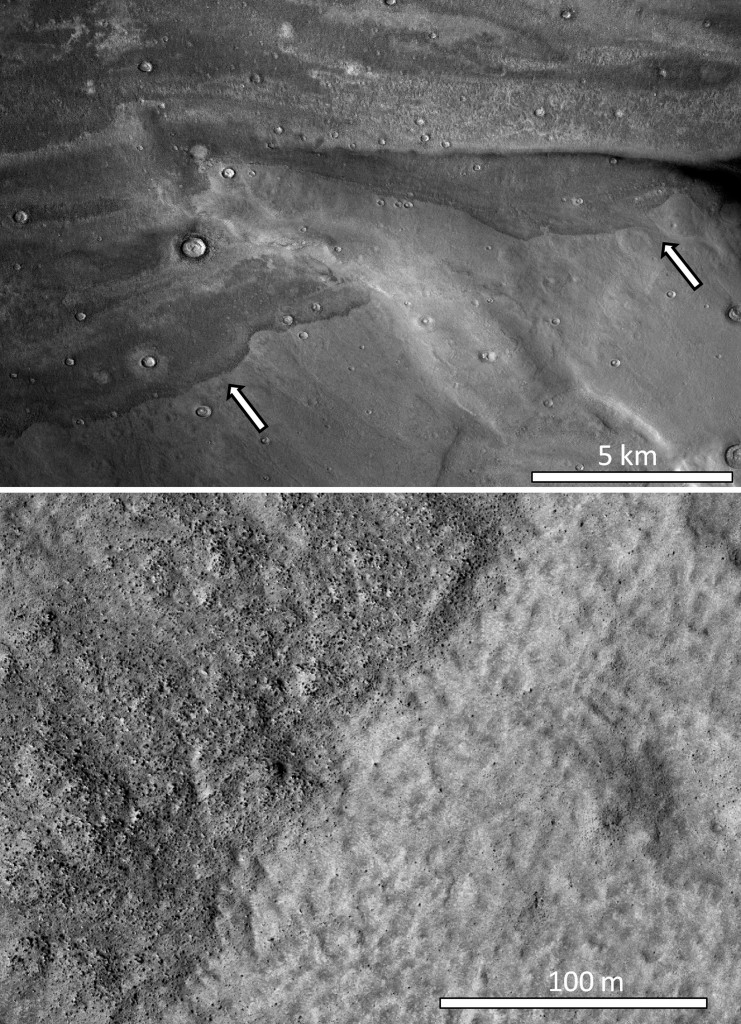
Monster tsunamis caused by meteor impacts swept across the northern plains of Mars more than three billion years ago, radically resculpting the edges of the Red Planet’s ancient seas, according to a study published on May 19, 2016. The findings, based on geological mapping, could provide new clues in the search for life.They also bolsters the theory that massive floods 3.4 billion years ago transformed Mars’ northern lowlands into a sprawling ocean, the study said./ AFP PHOTO /
by Marlowe HOOD
PARIS , France (AFP) — Monster tsunamis caused by meteor impacts swept across the northern plains of Mars more than three billion years ago, radically re-sculpting the edges of the Red Planet’s ancient seas, according to a study published Thursday.
The findings, based on geological mapping, could provide new clues in the search for life.
They also bolster the theory that massive floods 3.4 billion years ago transformed Mars’ northern lowlands into a sprawling ocean, the study said.
Some scientists had challenged that notion, pointing out that the alleged shoreline of this long-gone sea is today ragged and uneven — not a landscape one would expect to find ringing an ocean.
“Our discoveries reconcile the ocean hypothesis with the puzzling absence of shorelines distributed along a constant elevation,” lead author Alexis Rodriguez, a researcher at the Planetary Science Institute in Tucson, Arizona, told AFP.
These mega-tsunamis probably numbered in the dozens over hundreds of millions of years , but the study, published in Nature’s Scientific Reports, focused on two that happened a few million years apart.
The first carried boulders and debris tens, even hundreds, of kilometers inland. The second rose up during a much colder period, tossing off huge blocks of ice as the waves froze in mid-air.
Rodriguez and his team traced the ground zero of the tsunamis to two craters each about 30 kilometers (nearly 20 miles) across.
Frozen time capsules
The giant waves would have averaged about 50 meters (more than 150 feet) in height, but likely rose up some 120 meters (400 feet) — visualize a 30-story building — as they ripped up shorelines and rushed inland.
They each submerged areas roughly the size of France and Germany combined before retreating back into the primordial Martian sea.
No other explanation can account for the formations uncovered, said Rodriguez.
“The shapes of the deposits we mapped are indicative of upward flows” powerful enough to transport boulders hundreds of kilometers, he explained by email.
Mars is surely the most scrutinized planet in our Solar System (besides our own), and yet no one seems to have noticed the evidence of mega-waves in the Red Planet’s past.
“My guess is that we were trying to find shorelines on Mars like those we typically see on Earth,” Rodriquez said.
The second tsunami could provide a new hunting ground for signs of life early in Mars history.
The lobes of ice it cast off are probably made of water from the ancient ocean, making them frozen time-capsules billions of years old.
To have originally been in liquid form despite deeply negative temperatures, the water must have been very briny — dense, in other words, with salt.
“Subfreezing briny aqueous environments are known to be habitable on Earth, and consequently some of the tsunami deposits might be prime astrobiological targets,” said co-author Alberto Fairen, a researcher at the Center for Astrobiology in Spain.
Icy specimens are not far from the Mars Pathfinder landing site, and the researchers point out that future landers could collect and analyse samples.
mh/pvh
© 1994-2016 Agence France-Presse








